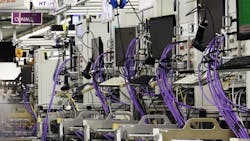In an earlier post about Hitachi Vantara’s digital manufacturing technologies, we noted Ericsson’s plan to use these technologies at its new greenfield 5G smart factory near Dallas. That factory began production last month.
The factory is Ericsson’s first smart factory in the U.S. (the company operates other smart factories in Sweden, Estonia, and China). For Ericsson, smart manufacturing means combining cellular Internet of Things and Industry 4.0 technologies. Using this combination of technologies enabled the company’s Nanjing, China, smart factory to deliver a 50% return on investment in its first year of operation, with breakeven expected in less than two years, according to Ericsson.
The factory will also produce Ericsson’s Advanced Antenna System radios, which are designed to “boost network capacity and coverage, including rural coverage, as well as 5G radios for urban areas,” the company said.
Ericsson highlights its use of 5G technologies in its smart factories to prove the value of the network technology to industry. “It’s exciting to use our own 5G products in the factory for wireless connectivity to increase production efficiency,” said Erik Simonsson, head of the Ericsson’s Texas 5G Smart Factory. “With the first 5G base stations now rolling off the production line, we are on target this year to have the most fully automated, sustainable 5G smart factory in the U.S.”
5G is used in the factory to enable its automated warehouses; connected logistics; automated assembly, packing, and product handling; and autonomous carts.
Leaders relevant to this article:



